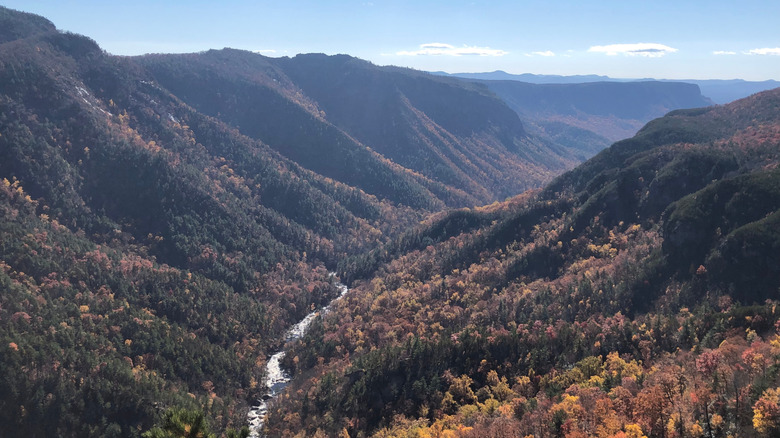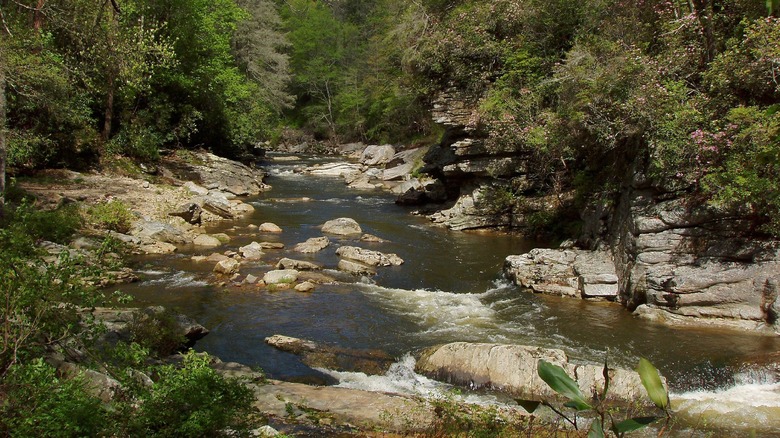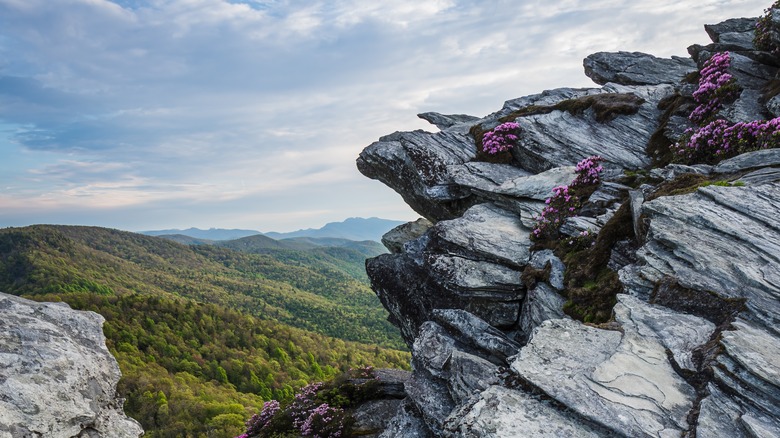One Of North Carolina's Most Magical Trails Is A Gorge Hike With Cliff Vistas, A Waterfall, And Unique Geology
Editor's Note: This area is recovering from the devastation caused by Hurricane Helene. Please check local reports and forecasts before making travel plans.
Mother Nature is at her best in North Carolina, and the mountainous sprawl of its breathtaking Western region is particularly appealing to outdoor enthusiasts. From the picturesque vistas along the Blue Ridge Parkway and the serene hills in Great Smoky Mountains National Park to the distinctive quartzite formations in the Linville Gorge Wilderness Area, the region's abundance of awe-inspiring views seems limitless. Located within the 500,000-acre Pisgah National Forest, the Linville Gorge Wilderness Area provides 39 miles of top hiking trails for different skill levels. A standout route for its craggy terrain and panoramic views, Babel Tower Trail is as picturesque as it is challenging. If you love adventure, lace up your boots and follow this 3-mile out-and-back trail that begins at the west rim of the gorge and backtracks to the Babel Tower trailhead.
Best known as "The Grand Canyon of the East," the Linville Gorge Wilderness Area is spread over 12,000 acres across both Burke and McDowell counties. Hikers will discover a wonderland of pine and hardwood forest, towering mountains and jagged cliffs, and sparkling waterfalls and shallow pools. Perpetually shaping Linville Gorge is the 12-mile stretch of the same-named river, which flows downhill nearly 2,000 feet, cascading from Linville Falls through the chiseled walls of the ravine. The Cherokee people called the Linville River "Ee-see-oh" or river of many cliffs. Known for being the deepest gorge in the Eastern United States, Linville offers stunning vantage points from its Hawksbill, Shortoff, and Table Rock peaks, as well as atop its eastern rim summits known as The Chimneys. But, you can enjoy a unique perspective from the floor of the gorge, and the Babel Tower Trail will lead you there.
The Babel Tower Trail is a rugged footpath laden with natural wonders
Keeping a moderate pace, it takes under two hours to complete this mountain hike with a pristine payoff and scenic views, but take time to fully admire the untamed beauty of its cliff vistas. As you descend the trail, you'll navigate a mostly unmarked wilderness with steep inclines and uneven boulders, and dramatic vistas are a just reward. Passing through hardwood forest draped with mosses and wildflowers reveals the trail's pièce de résistance, the Babel Tower. Rising 400 feet above the river, this imposing spire lives up to its name, perhaps a nod to the giant biblical myth. At the gorge's eastern rim, enjoy panoramic views of the river, gorge, and Hawksbill and Table Rock peaks. Brave the extra climb to Babel Tower summit to peer down at its steep precipices. Circling back toward the trailhead, where the forest meets the gorge floor, you'll get an up-close view of the chasm's jagged walls. You can swim in the river shallows, where water pools slowly over protruding boulders. Keep an eye out toward the hike's end, where the river runs through a narrow fissure into the 10-foot cascades of Babel Tower Falls.
Naturally, all outdoorsy travelers should take along their best gear when taking a hike on vacation (no matter where it is). Make sure to bring a GPS, compass, and map, and carry binoculars for birding and a better look at other wildlife around the trail. Located near Linville Falls on Old N.C. Highway 105 in Newland, the Babel Tower Trail is about one hour and 19 minutes' drive from Asheville and two hours and 38 minutes' drive from Charlotte.
Discover geology created from ancient earth science
While you hike the Babel Tower Trail, you'll want to take a closer look at the breathtaking landscapes and legendary rock formations that create the Linville Gorge's awe-inspiring scenery. Defined by its lofty cliffs, deep ravines, and jagged rockface, the gorge stands out as a unique topographic feature within the Blue Ridge Mountain range. Recognizing its geological importance, President Lyndon B. Johnson designated Linville Gorge one of the country's two original wilderness areas when he signed the Wilderness Act into law in 1964. Fashioned over time by the erosion of both igneous rock, formed from cooled magma, and metamorphic rock, transformed by heat and pressure, this harsh wilderness topography is an open-air museum of environmental geology.
Each of the gorge's striking outcroppings is an assemblage of alternating layers of different rock types which create its geological foundations. Mainly east of the Linville River, quartzite rocks date to the Precambrian age of Earth's early history, millions of years ago. When the tectonic plates shifted, and these giant rock slabs tumbled riotously over one another, they left cracks for molten rock to rise from the Earth's mantle. These geological events formed intrusions of crystalized magma hidden between the gorge's rock layers, which were eventually lifted to the surface by intense erosion. And as you observe the sheer depth of the gorge walls along the Babel Tower Trail, yet another geological phenomenon known as stream capture or stream piracy comes into play. Several geologists' research proposes that the headwaters of the North Toe River were diverted into the steeper Linville River, dramatically increasing its flow and slope erosion. It's certainly a sight to behold, especially for science lovers.


